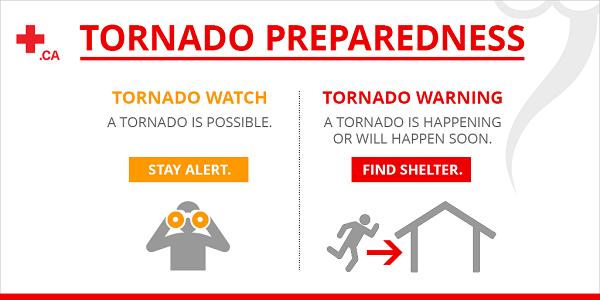Tornadoes form inside special thunderstorms called supercells. Supercells are violent thunderstorms that contain hail, lightening and high force winds.
However, a supercell is not enough to create a tornado.
To form a tornado, you need several other ingredients including warm rising air and significant amounts of condensation. The updrafts and downdrafts that form during these conditions can eventually create a violent rotating column of air that can be a few meters to over a kilometer wide!
In Canada, tornadoes can happen in southern Alberta, Manitoba, Saskatchewan, Ontario, Quebec, the interior of British Columbia and western New Brunswick.
So, what should you do to be ready for a tornado?
Before a Tornado:

-
Download the Red Cross Be Ready App for instant access to information about disasters in your area.
-
Make a plan. Pick a safe place inside your home for you and your family to hide if there is a tornado, ideally in the basement. If you do not have a basement pick a centre hallway, bathroom, or closet on the lowest floor.
-
Put together a personalized emergency kit. Your kit should include basics like cash, non-perishable food, water and a flashlight. However, make sure to also add items that are specific to your family. For example, pet food if you have a pet, and any medication you or a family member may need. Make sure your kit has enough of everything to last 72 hours.
During a Tornado:
-
Learn to spot the signs: dark often greenish or orange-grey skies, large hail and large, dark, low-lying, rotating or funnel-shaped clouds.
-
If you are at home go to your basement or your centre hallway, bathroom, or closet on the lowest floor.
-
If you are in a high-rise go to a hallway in the centre of the building.
-
If you are outside go to a nearby sturdy building. If there are no buildings around lie flat in a ditch or low-lying area.
-
Do not stay in your car or mobile home because they can be blown over.
-
Bottom line: stay away from windows, outside walls and doors.
After a Tornado:
-
Everyone responds to disasters differently. After a tornado, check on vulnerable neighbours, family and friends in case they need help. And make sure to comfort your pets.
-
If you were away from home don’t re-enter until it is safe.
-
Stay away from any damaged areas and fallen power lines. Keep an eye out and avoid debris and broken glass.
-
Listen to the radio for any further alerts.
-
Make sure to wear long pants, a long-sleeved shirt and sturdy shoes while you are examining your property for damage.
-
If you notice any damage, take pictures for insurance claims.
After any disaster take a moment to review your emergency plan and restock that life-saving emergency kit!